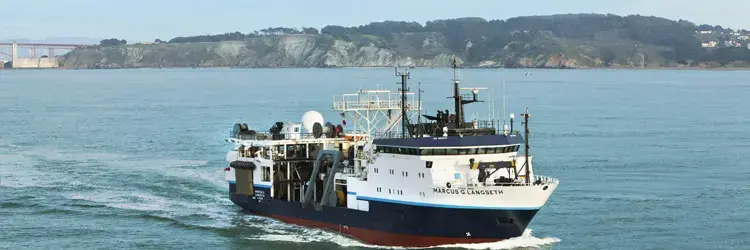
Overview:
We are opening a call for the selection of current M.Sc. or Ph.D. students along with early career scientists to participate in the NSF funded project AXIAL aboard the R/V Marcus Langseth during the summer of 2019. The 33 day research cruise will allow participation in all facets of ship operation, including deployment of scientific instrumentation, keeping watch during data collection, initial onboard data processing, an onboard reading and discussion group and workshops for mapping and seismic processing. We encourage a diverse group of participants including women and demographics underrepresented in the geoscience community.
Scientific Background:
Axial volcano is the locus of volcanic activity of the Cobb-Eickelberg hotspot chain along the Juan de Fuca ridge, approximately 450 km off the coast of Oregon. A large horseshoe shaped caldera with hydrothermal vents marks the summit of the volcano and is the focus of the imaging efforts. Axial volcano is one of the better-studied mid-ocean ridge systems. There are numerous, ongoing and long-term observations across the volcano and there have been several different sets of OBS and 2D MCS data collected. Conducting a 3D survey will add a tremendous amount of information to the current understanding of the complex magma chamber. Because there are limitations to how 2D seismic data can image features that dip, or structures like ring faults or magma conduits, there are still many questions as to how this active volcano operates. 3D data will eliminate these limitations and give a more full understanding of volcanic systems worldwide.
Purpose:
The research goals of the AXIAL cruise are to collect a combination of 3D seismic reflection data and a set of longer 2D seismic reflection profiles in order to image the complex 3D nature of the Axial volcano. We aim to understand the magma transport mechanisms within and above the crustal reservoir, image the 3D nature of the fracture network of the chamber, and to connect the subsurface features to the vents and fissures on the ocean floor. Previous seismic refraction data imaged a large and long-lived crustal magma reservoir beneath the caldera and later reflection profiles identifies a fracture network above the volcano.
How this works:
We are looking to have 8-10 high-quality participants whose focus is in seismology, geophysics (e.g. electromagnetics, gravity, bathymetry, etc) volcanism, or other relevant geoscience to participate in the cruise. The application process will include submitting a CV a letter of intent (i.e., why you are interested in this experience, how it reflects on your graduate research and what you hope to learn, etc.), and a letter of support from supporting graduate advisor(s). Please email your (1) CV, (2) Letter of Intent, and (3) Advisor Letter of Support as one pdf file saved in the following format "YourLastName_Axial_Application.pdf" by April 1st to Dr. Annie Kell (kell@seismo.unr.edu). Project funds will pay for transportation to and from port in the port of call and for per-diem while in port. All meals and accommodations will be provided while aboard the research vessel.
The cruise is scheduled for 33 days at sea, so applicants must be available for the duration plus time at port (a total of 37 days) in the summer of 2019. The current dates to be at sea (not including travel and preparation days at port) are July 9 – August 12, though please be aware that these dates are subject to some change. During time on the ship, participants will work shifts with the project PIs and other science crew aboard the vessel. Data is collected 24 hours a day, and participants will stand watch for 8-hour shifts for the duration of the project. All levels of graduate students from any geoscience backgrounds are welcome to apply.
Please send any questions to Dr. Annie Kell (kella@seismo.unr.edu) and Dr. Adrien Arnulf (aarnulf@ig.utexas.edu)